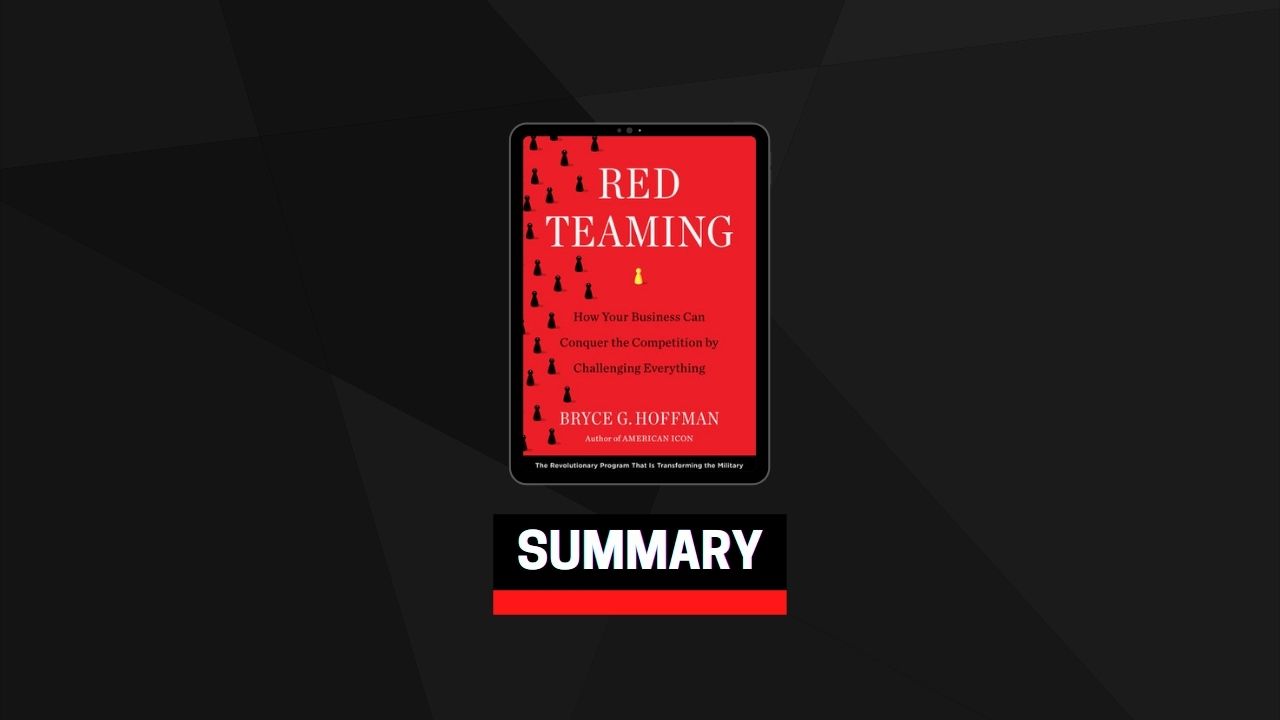What Is Red Teaming?
On August 11, 2015, Larry Page, the cofounder of Google, sent a letter to his staff announcing one of the most stunning developments in the recent history of the high-tech industry: Google was creating a new company, Alphabet Inc. It would be a new type of conglomerate, and Google itself would become one of its many subsidiaries. It was a radical restructuring that nobody saw coming, least of all Google’s employees. In his memo to them, Page explained the rationale behind the move:
We’ve long believed that over time companies tend to get comfortable doing the same thing, just making incremental changes. But in the technology industry, where revolutionary ideas drive the next big growth areas, you need to be a bit uncomfortable to stay relevant.
That is what red teaming does. Red teaming challenges your plans and the assumption upon which they are based. Red teaming forces you to think differently about your business and consider alternative points of view. Red teaming makes critical and contrarian thinking part of your company’s planning process and gives you a set of tools and techniques that can be used to stress-test your strategy. Red teaming helps you better understand your customers and your competitors. Red teaming helps you scan the business environment for both threats and opportunities. Red teaming shows you the dangers that lie ahead—and how to turn them to your advantage. Red teaming may make your organization a bit uncomfortable, but it will also help you stay relevant, keep ahead of your competition, and cope with an increasingly uncertain world.
As the U.S. Department of Defense explains: Red teams are established by an enterprise to challenge aspects of that very enterprise’s plans, programs, assumptions, etc. It is this aspect of deliberate challenge that distinguishes red teaming from other management tools.
Seven Rules of Red Teaming
Rule 1: Don’t Be a Jerk
That does not mean red team members should avoid conflict, because conflict is inherent in the red teaming process. A red team should never compromise the integrity of its work to avoid hurting someone’s feelings or, worse, for the sake of internal politics. But a red team should go out of its way to present its findings as respectfully and constructively as possible.
Good leaders know that there is nothing intrinsically wrong with conflict. Some, such as legendary Intel CEO Andy Grove, have actively encouraged it. Grove believed what he called “constructive confrontation” was key to his company’s success.
Dealing with conflict lies at the heart of managing any business. As a result, confrontation—facing issues about which there is disagreement—can be avoided only at the manager’s peril. The issue can be put off, it can be allowed to fester for a long time, it can be smoothed over or swept under some rug. But it is not going to disappear. Conflicts must be resolved if the organization is to go forward. Constructive confrontation accelerates problem solving. It requires that participants be direct….It pushes people to deal with a problem as soon as possible, keeping it from festering. It encourages all concerned to concentrate on the problem, not on the people caught up in it.
Rule 2: Red Teams Must Have Top Cover
In a business setting, a red team will be most effective when it reports directly to the CEO and enjoys his or her full support. In practice, that will not always be possible. Red teams can still be effective when they report to the head of a department or division, as long as their scope is limited to those areas. If the red team tries to tackle problems outside of those areas, it is bound to find itself in conflict with other senior executives.
If your red team does not report to the top of your organization, then it should do whatever it can to include senior leadership in its work. The red team should solicit the management’s input before beginning any red teaming exercise in order to make sure the leadership’s concerns are addressed and any limitations it might feel the need to impose are respected. The red team should also share its findings with those executives directly—preferably by inviting them to sit in on the final briefing, but at least by giving them a copy of the final report.
Rule 3: Red Teaming Only Works If You Let It
Even when red team members conduct themselves blamelessly, it can still be a challenge to get the entire organization to embrace red teaming and take the red team’s recommendations to heart. In the military, resistance to red teaming has come largely from officers who do not fully understand what red teaming is or why it is necessary. Once they are briefed on red teaming, that resistance usually dissipates. Successful units also tend to resist red teaming. They think that because they have been successful in the past, they know what it takes to be successful in the future. That is the sort of thinking that led to the collapse of the American automobile industry.
It is hard to red team effectively if the red team is not allowed to look at all aspects of a company’s operations. It can be done, but only with the proviso that the results may not be as complete as they would have been if everything had been open to critical analysis. That is understandably challenging for many organizations. Some companies will want to take sensitive issues, such as those involving personnel or trade unions, off the table. But a red team needs the freedom to look at all aspects of the business in order to conduct a thorough analysis.
Sometimes, that will simply not be possible. The board of directors may have already vetoed a particular course of action. Regulatory requirements or union contracts may limit a company’s options. In situations such as these, it is important to remain mindful of the adage, Don’t let the great be the enemy of the good. We live and work in a world where available courses of actions are often limited by politics, personalities, or purse strings. Red teaming within predefined lines is still better than not red teaming at all—unless those lines are put in place to shape the outcome of the red teaming exercise.
Rule 4: Don’t Red Team Things to Death
There is such a thing as red teaming an issue or idea to death. The most effective red teams are those that have figured out how to red team just enough, but no more than necessary to solve the problems they are tasked with analyzing. Ineffective red teams waste time plunging down one rabbit hole after another.
If you are asked to red team your company’s plan to introduce a new line of running shoes, concentrate on stress-testing that plan. Do not use this assignment as an opportunity to explore whether a new line of hiking boots might not be more profitable or to question whether your company should be in the shoe business in the first place. If you are asked to analyze a proposed merger with XYZ Corporation, focus on the risks and opportunities of that tie-up. Do not use it as an opportunity to reevaluate your company’s entire business strategy.
It is counterproductive for a red team to analyze every decision an organization makes. Constant red teaming can be stressful and demoralizing for employees who have their every move questioned and challenged. That is not the point of red teaming, nor is it an effective use of red teams.
A red team should be used strategically and selectively. It should be brought in to analyze important decisions, major deals, and overarching strategies. It should be called on when problems cannot be satisfactorily solved through regular means.
Rule 5: Red Team Your Red Team
Red teaming should never become routine. Red teaming is all about looking at things differently, so you need to avoid the tendency to approach every problem the same way and with the same techniques. That can be a challenge, because when we find an approach that works, we tend to keep repeating it. And when we do, we start to get lazy and less alert to the dangers of bias and groupthink.
A red team should always challenge itself. It should always encourage its members to voice different perspectives and conflicting views.
Mixing up the way the team uses those tools and techniques is also a good idea. If you approach every problem the same way, you run the risk of making red teaming a bureaucratic exercise rather than the game-changing tool it should be. In addition, using the same methods over and over again can yield red teaming reports that read remarkably similar to one another, making them easier to ignore.
Rule 6: You Don’t Always Have to Be Right—But You Can’t Always Be Wrong
A red team that is always wrong will never be taken seriously. Its warnings will be ignored. Its reports will go unread. Its members will lose their credibility. For that reason, red teams do need to pay attention to their track record and make sure that they hit the ball out of the park, at least occasionally.
If your red team is incapable of doing that, then it is doing something wrong. Because while red teams do not need to be right, they do need to be credible. If the red team misunderstands the problem it was asked to solve, recommends actions that have already proven unsuccessful, or suggests alternatives that are ethically, legally, or financially impossible, it will lose its credibility.
Rule 7: Don’t Give Up
Sometimes, red teaming can be a lonely occupation—particularly if you are red teaming in an organization that does not want to learn, to change, and to grow.
Solutions to such problems rarely come in the form of quick fixes or easy answers. And, too often, those are the only solutions an organization wants to hear.
Many companies like simple solutions that do not require too much effort to implement. They prefer short-term fixes that offer immediate results, even if they do little to address the underlying problem. They are less interested in long-term solutions that require a coordinated effort to implement and that often take time to move the needle in a big way. But as Peter Senge warned in The Fifth Discipline, “The easy way out usually leads back in.”


